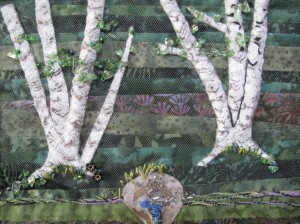Although the preacher never used the term, pentimento, I heard a sermon this morning that used the concept of pentimento to encourage us to be more honest, healthier, less fearful, about revealing our mistakes rather than engaging in elaborate cover-ups. It was not until this evening, however, that I learned that the term actually comes from the Italian pentirsi, which literally means ‘repentance.’
Pentimento refers to changes in a piece of art, specifically by the original artist (as opposed to someone later adding a fig leaf or other “improvement” to a painting). These are places where an earlier version of the work is visible  through the final layer – perhaps the angle of a face has been altered, clothing has been simplified or made more ornate, or the artist has gone back and touched up an aspect she or he no longer likes. Depending on the quality of the original paint, sometimes the under-layer is the faintest shadow, sometimes it bleeds through extensively.
through the final layer – perhaps the angle of a face has been altered, clothing has been simplified or made more ornate, or the artist has gone back and touched up an aspect she or he no longer likes. Depending on the quality of the original paint, sometimes the under-layer is the faintest shadow, sometimes it bleeds through extensively.
It is something that really doesn’t happen in my own art – or at least doesn’t happen in the same way. Fabric and fiber are very different media than paint – usually when I cover something up, it stays covered. Although I do make mistakes, like melting the netting at the base of the trees. [If you click on the image and scroll down to the roots, you will see it on the left.]
But pentimento happens in my daily life – which was what the minister was asking us to consider. Sometimes it happens quite deliberately and sometimes almost by chance. Sometimes it happens for appropriate and life-giving reasons; sometimes as an attempt to cover up shame or fear.
You have heard the adage that history is written by the victors. Indigenous peoples, women, the illiterate, the voiceless, people from races or ethnicities or religions other than the dominant one in a culture, gay, lesbian, and transgender persons, have all had their experiences “painted over” by those in power. As a female citizen of the United States, I have noticed more than one example recently of those who consider themselves more moral or more just or simply more powerful, explaining “what women think” or “what women need” (or “what the poor think” or “what the homeless need”) as if we cannot be trusted to articulate our own thoughts or needs. Friends who are Native American or African American or Muslim report the same phenomenon. And it takes fierce and steady witness to reveal the real picture of who we are, what we think, and what we want.
Yet what seems even sadder than having my experience painted out by someone else, is choosing to do it to myself. How many times have I painted over my skills, my strengths, my visions, my intelligence, my dreams, my creativity, so that my image (my “painting”) will conform to some expectation of the world? I ask myself who I am really serving when I fear to reveal the truth of who I am.
And I ask myself how faithful I am being when my own spiritual myth tells me that I am created in the image of G-d. Why would I ever choose to paint over the beauty and grace and love and wonder of Holiness?
I invite you to join me this week in putting down the paintbrush and – just for this week – refusing to paint out or paint over the sacred image within.
–Andrea
Text © 2014, Andrea La Sonde Anastos
Photo © 2013, Immram Chara, LLC